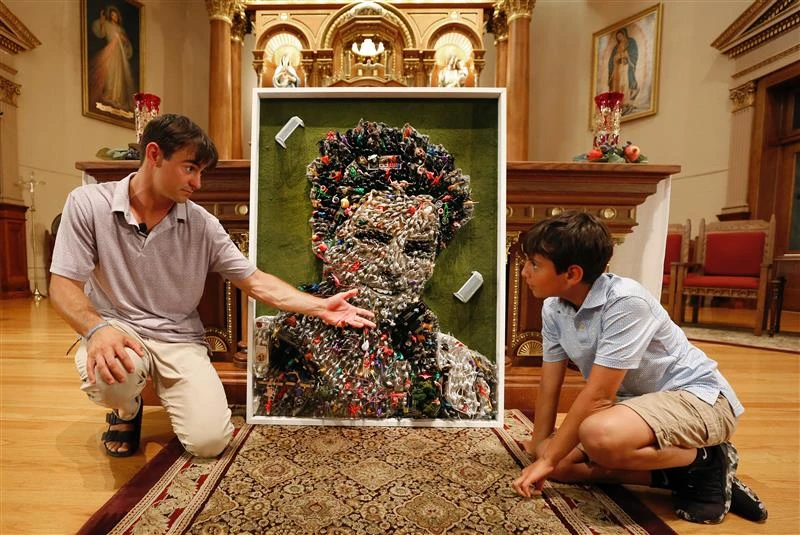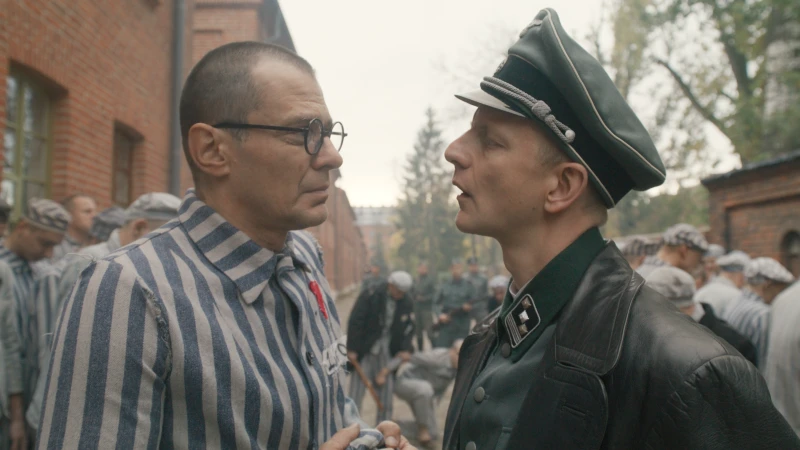

Artist Johnny Vrba presents the commissioned Carlo Acutis piece to kids at St. Carlo Acutis Parish in Chicago. / Credit: Photo courtesy of Chicago Catholic
Washington, D.C. Newsroom, Sep 9, 2025 / 10:00 am (CNA).
As the faithful continue to celebrate the canonization of St. Carlo Acutis, a 1,000-piece mosaic portrait of the new saint made of toy soldiers, Pokémon, shoelaces, and other surprises hangs in Rome.
After artist Johnny Vrba heard about Acutis, he was inspired to create a portrait of the saint out of recognizable items that visually tell his story. Vrba has now crafted and presented two portraits of Acutis to help young Catholics learn about the first millennial saint.
“Every figure, every toy, every single thing that is glued on the piece has a meaning and a purpose,” Vrba told CNA. “It’s all on there for a reason. Every single one of them is numbered, just like Scripture says: ‘He hasn’t just counted them, because he’s numbered us. He’s numbered the hairs on our heads.’”

Discovering ‘an ordinary, but extraordinary, saint’
Vrba was raised Catholic but didn’t completely commit to his faith until an unexpected trip established his relationship with Christ.
In 2020, Vrba was on a study abroad trip sailing to Shanghai, China, when the COVID-19 virus broke out. “The voyage did not go as planned, but during that uncertain time I actually met the Lord for the first time in a really powerful way.”
After the experience, Vrba got involved in missionary work, was in school, and created a bit of art on the side. He had always enjoyed painting and building small toys and thought: “I wonder if there’s a way to combine drawing, painting, and this sculptural component.”
Vrba put faith and art together to create a couple portraits of Jesus with the Crown of Thorns. One is made of wine corks to represent Jesus’ miracle in Cana, and the other is crafted of toy soldiers. Then a friend of Vrba’s told him about Acutis, inspiring the next steps for the young artist.
“I’d never heard of Carlo Acutis. He was totally under my radar,” Vrba said. “Then I researched him and thought: ‘He has some very similar things to my own story and synchronicities.’ Like bringing his parents to the faith and bringing them to Mass. Then being into technology and filming and animals, like his dogs and cats. He’s just such an ordinary, but extraordinary, saint.”

“I started dreaming about what a piece could look like,” Vrba said. He decided his next sculpture would be an image Acutis made of toys, because “Carlo would have played with video game controllers, and played Pokémon and Mario.”
‘The First Millennial Saint’
Creating the mosaic was no simple task. Vrba had to track down thousands of quality soldiers and toys, paint them, and meticulously glue each one in place. The result was the 45-pound mosaic called “The First Millennial Saint.”
“Every toy has a meaning and a purpose,” Vrba said. Many of the soldiers are turned facing a figure of the crucifixion to represent “the culture of death.” They are “flaccid, boring, colored, gray, white, and black figures that are all pointing at the cross — pointing at Jesus.”
There are also colorful soldiers that are “outward-facing, evangelizing, and filled with the joy of the Gospel.” The 163 colorful figures represent Christians who are fighting against the culture of death and also the 163 Eucharistic miracles Acutis documented on his website.
The sculpture also has dozens of hidden “Easter eggs” that viewers might just miss, including a dolphin and various Pokémon characters hinting at Acutis’ favorite animal and favorite game. The background is even a soccer field to represent his love for the sport.
“People really gravitate towards the computer desk setup. It has a saxophone, the Bible, a world map, a little soda, and his dogs and cats around him where he would have worked at his little station. It blends right in with the piece, you would never even know, but when you turn your head sideways you can see it.”
“Then both of the miracles are incorporated,” Vrba said. The miracle of Mattheus, a young boy from Brazil who was healed from a birth defect that caused him difficulty eating is represented with small steak and french fry figurines, because it was the first meal he was able to consume after his mother asked Acutis to intercede for her son.
The sculpture includes a bicycle to represent the miracle that saved Valeria Valverde, a young Costa Rican woman who suffered a serious head injury from a bike accident in Florence. The toy bike is “placed on Carlo’s head where she cracked her head and suffered brain hemorrhaging.” After her mother prayed at Acutis’ tomb, she made a complete recovery.

A mission of more than just art
Vrba created the original mosaic for Acutis’ mother, which he planned to give to her during a meeting at Acutis’ canonization in April. After it was postponed due to Pope Francis’ death, the meeting was unfortunately canceled. Since the piece had already traveled to Italy, Vrba decided to take it to the church where Acutis is buried in Assisi.
The sculpture traveled around the city where Vrba showed it to pilgrims and placed it in spots Acutis once stood himself. After gaining traction on its journey, it was acquired by and placed in the Vatican’s youth center.
While in Assisi, Vrba also met a number of parishioners of St. Carlo Acutis Parish in Chicago — the only church in the United States named after Acutis. One parishioner commissioned a replica of the piece that Vrba created with even more details than the original.
Inspired by Acutis’ quote “We are all born originals, but many of us die photocopies,” Vrba ensures each work of art, even replicas, are different. “I want to make every piece unique, because every person is unique. Die as an original, not as a photocopy.”
Vrba presented the original during the Jubilee of Youth and the replica to kids at St. Carlo Acutis Parish. When kids see the sculpture Vrba loves that they realize “each figure on the piece has a special mission, and each one of us in the Church [has] a special mission. We are made for a purpose. We are the lifeblood of the Church.”
“I want to make art that people don’t just look at but look into. And it’s the greatest joy in my life when kids come up to it and they’re able to touch things, push buttons, and they can get their hands on it, interact with it. I love seeing them look into it.”
Vrba is currently working on four pieces that will be shown at Miami Art Week in December, including portraits of St. John Paul II and newly canonized St. Pier Giorgio Frassati. Vrba’s art will be one of the very few, if not the only, religious pieces at the mostly secular show.
“Then the goal would be to use those pieces at school parishes, stand-alone parishes, churches, and any Catholic missions to preach the lives of the saints.” He added: “The mission is to speak and evangelize, and especially, convict the universal call to holiness in an artistic way … using the commonplace household items and toys that people recognize.”
Read More

